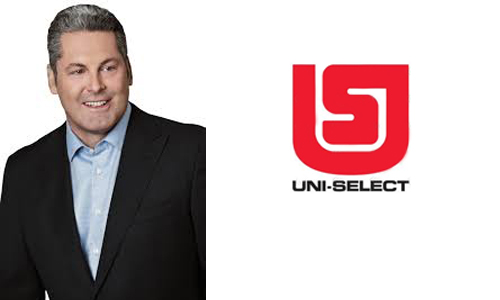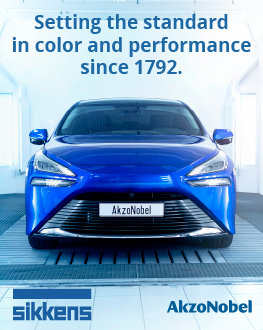Toronto, Ontario — July 31st, 2017 — On this week’s Tuesday Ticker, we look at Uni-Select’s reports of strong business in Canada. Henry Buckley notes the business trends driving growth in the Great White North.
Strong Growth
The Quebec-based paint distributor announced second quarter financial results last week. The president and CEO of the company, Henry Buckely, hosted a conference call delving into the numbers. As one of the relatively few publicly traded companies in the sector, the call provided some unique insight into the business. Analysts seemed to be intrigued by the strong growth in Canadian operations. According to Buckley. The Canadian Automotive Group achieved very strong sales and earnings in the quarter with organic sales growth of 6.2 percent and an earnings margin of 8.6 percent on sales.
“Organic sales were positive with our independent jobber customers as well as both our Bumper to Bumper and FinishMaster corporate stores,” said Buckley. Eric Bussieres, CFO of Uni-Select, was also on the call. He noted the effect the strong Canadian operations had on overall corporate earnings. “Consolidated sales for the second quarter reached $340 million, an increase of 5.1 percent against second quarter 2016. This increase is driven from recent business acquisitions as well as strong organic growth in Canada. The Canadian Automotive segment sales rose to almost $131 million, an increase of 2.8 percent, despite a foreign exchange translation headwind of approximately $5.7 million. When normalized with the foreign exchange translation impact, the total growth would have been 7.2 percent,” said Bussieres. “The strong sales in Canada are partly attributable to sales initiatives and to a lesser extent, the spring maintenance activity that partly shifted from Q1 to Q2. Second quarter consolidated adjusted earnings were $32.5 million compared to $29.7 million last year, an increase of over 9.1 percent driven by strong contribution from our Canadian operations. To summarize the quarter: Strong performance by the Canadian operations during the quarter and after six months of 2017 helped earnings.”
During the question and answer period, Leon Aghazarian, research analyst, National Bank Financial, asked about the strong organic growth in Canada. “I mean that’s obviously a very strong number at 6.2 percent. You do mention that both the corporate stores as well as the distribution centres contributed to that. Can you just give us a bit more colour as to maybe the split there and then some underlying reasons behind that growth,” said Aghazarian. Responding to the Buckley’s question, that while the company doesn’t share data about differences between stores and independent jobbers, “quite frankly they’re roughly equal all across the board for us in the quarter. We’re very pleased with the progress we’re making with the corporate stores, both Bumper to Bumper and FinishMaster are delivering great results, and equally, we’re just as happy with independent jobbers. They had a very, very good quarter and they seemed to be continuing into July.”
Aghazarian went on to ask about the sustainability of this margin going forward. “That’s a very strong number at north of 8 percent. So I’m just trying to see, is that related primarily to some of the initiatives that you’ve implemented, or is that really because you’re pushing more corporate stores out and thus the margin profile is a bit different there?” Buckley responded, “It’s fair question. At the end of the day, for us, it’s related to volume, right. We’ve got a very efficient model in both segments. Our corporate stores both Bumper to Bumper and FinishMaster are producing strong earnings results. Our independent jobber segment, that’s something that’s historical for us, we’ve always had a very good foundation there so we’re continuing to see that move forward for us it’s about volume. The earnings results will flow from that.”
In reply to a question about the flat growth in the United States, Buckley admitted the early part of the year had been slow. “I think for us overall, the market in the first quarter or second quarter has been softer than we would like. I think that’s indicative of the environment. We’re clearly the only public company in our segment in terms of public companies publishing, but if you look at the manufacturing side of the business, the manufacturers are all—it’s coming off a second quarter that was softer than they expected as well. I think we’ve got some sort of market softness which has, been offset by our growth initiatives. There are growth initiatives that we have in both the traditional customer segment for vehicle refinish, and the MSO segment for vehicle refinish. So nothing has changed for us there. We’ve got our head down and we’re executing on those fronts. The backdrop isn’t as robust in terms of the sort of economic base but we don’t see that sort of lasting longer term. I think all of our manufacturers are looking for a much better third and fourth quarter. I think that’s the outlook from them, we certainly see the same as well.”
Play-by-Play
Benoit Poirier, Research Analyst for Desjardins Securities, asked the Executives to “provide more colour on the softness you see on the paint side, whether it’s related to the weather or is it related to something else.”
Steve Arndt, President and Chief Operating Officer, FinishMaster: “Most of the manufacturers, including us, have had a soft first half of the year and a lot of it is related to the weather. In several of the areas, we didn’t get any winter and that’s not good. Most of our shops in those areas were slow but we see very positive signs and we’re very optimistic about the second half of the year.”
Henry Buckley: “Hate using the excuse to weather like that. Everybody seems to be having to deal with that this year, sadly, but that is what it is.”
Benoit Poirier, Desjardins Securities: “Could you, Eric, provide some colour about the impact of the Canadian dollar on the debt level and also the potential impact you might see on the pricing of parts and paint?”
Eric Bussieres: “So in terms of debt level, Benoit, we have a very small amount. I think as end of June, we had less than 30 million borrowed in Canadian dollars. The balance was mostly, well—actually—the balance was all in the US dollars. “
Benoit Poirier: “When you look at the impact on the pricing parts and paint, anything we should expect? With respect when you look at the pricing, any implication we might be expecting going forward given the movement and the currency on the paint side?”
Eric Bussieres: “No. I’ll tell you what, the reality is in Canada, the manufacturers have not pushed for the price increases a year and a half ago, it’s not even two years ago. And if you look at that time, the Canadian US dollar was around $0.80 a dollar. We’re back to those levels right now so the reality is that manufacturers have not pushed the prices up when the Canadian dollar further depreciated. So we don’t see why that pricing mechanism would change at this current point in time. And in the US it’s I think PPG, Exalta, they’re all manufacturing the very, very vast majority, about 90 percent of it is out of the US. And the two foreign manufacturers are producing most of it also in the US, so it’s a US dollar cost to US dollar operations and revenue.”
Henry Buckley: “To be clear, we have not seen price inflation in Canada since December 2015. So these guys did not. They absorbed the exchange rate impact of the last two years. They’re very stable. They want to keep the market stable. So we’re not seeing price inflation there. We don’t expect to see price deflation. In the US, I will add though, there is price increases that come every single year and now, we’re coming into that season. So we’re expecting and it’s already been announced, price increases with our major paint manufacturers coming here in sort of August is kind of the starting point for that. So we’ll see some price inflation coming in the back half of the year.”
Elizabeth Johnston, Laurentian Bank Securities: “Do you think we could go back to the Canada segment automotive and earnings margin? Can you give us a sense of the magnitude of the offset that you had on that margin from the ongoing investments in corporate stores?”
Eric Bussieres: “No, we don’t give that detail of information, Elizabeth as you know. All I can tell you there, is that there hasn’t been a major shift in our investment pattern from Q1 to Q2. So that would not be the explanation of why the margins went up. As was explained by Henry earlier on, a lot of it is driven out of the volume of the business, and as we disclosed there, some of the compensation aspect were a little bit lower than the prior year.”
Henry Buckley: “Just to be clear, our foundation build in terms of rolling out PartsWatch and rolling out the rebranding and launch of Bumper to Bumper is on track. We’re kind of rolling that sort of consistently through the year. So there’s not going to be major spikes in one quarter or the other. So we’re very, very happy with the progress on that.”
Elizabeth Johnston: “And do you expect to be finished with those initiatives by the end of 2017?”
Henry Buckley: “Not all. I think we’ll get through the majority of it through the end of the year, but as we keep opening and adding stores, there will be more that roll into the sort of first quarter. So I’d expect some in the first quarter of next year because we’re going to do it at a pace where we can do it sensibly, digest them, stand them up, and that’s exactly what we’ve done. So we’ve adjusted the schedule a little bit, absorbed earnings from each one we do, accelerated some, and decelerated others. So again, happy with the progress but it will roll over into the first quarter.”
Elizabeth Johnston: “And can you give us a sense in terms of corporate stores what percentage approximately have had the branding completed at this point?”
Henry Buckley: “There’s two. Branding is one part of it. We have about 29 of the stores on PartsWatch now. That means IT and branding and everything. Interior and exterior, 32 exteriors and 11 were completed interior. So it’s a combination.”
Elizabeth Johnston: “And just one more if I may on earnings margin in Canada again. You highlighted that the better growth margin as a result of higher margins to install. Is there anything related there to the loss of the independent member you disclosed in Q1?”
Henry Buckley: “As our ratio changes a little bit from corporate stores to independent jobbers, we’re having store up margins, which are at a higher level than what the independent jobber margins are. So over time, I think you’ll see those creep up, but equally so, so do our headcounts and everything else. So that’s a balance. The independent jobber, I think Eric mentioned it, had we retained that business, which we’re not unhappy about, by the way. So as I think I’ve shared with most of you, we’d be sort of circa 10 percent growth on organic. So very significant organic growth. Very happy with the results.”
Elizabeth Johnston: “And further to your point on organic growth, are you seeing this across Canada or is there a particular region where you’re seeing a strong growth?”
Henry Buckley: “No, it’s across Canada. We’re seeing it across all the regions in Canada across our segments, independent jobbers and both Bumper to Bumper and FinishMaster stores. We’re very happy with the progress.”
Jonathan Lamers, BMO Capital Markets: “Okay, great. And on the refinish paint, Henry, you mentioned there will be some price inflation in the second half. Can you speak to how price inflation was in the first half of the year. Can you speak to the magnitude of price inflation that you’re hearing from the suppliers?”
Henry Buckley: “It’s similar to last year quantifying is around low singles. They don’t go up 10 percent. Their stuff is always sort of low singles.”
Jonathan Lamers: “And on Canada, I understand that there has not been any price inflation since December 2015 but will the fluctuation of the Canadian dollar provide some near term opportunities to capture some additional margin?”
Eric Bussieres: “Not really, Jonathan. I don’t foresee that. As I said, the Canadian dollar right now is more or less the same level it was about two years ago, a year and a half ago. So we don’t expect any price pickup or price reduction on that side. Margins should remain pretty stable as it relates to the product itself.”
Henry Buckley: “The one thing that’s nice about seeing the Canadian go up is that we’re at a lower tax rate in Canada on the earnings side. So it’s helpful. I think one of the things I’ll tell you, the Bumper to Bumper stores are doing really, really well and as we looked across the country, we had some historically they’ve always done really well. Bumper to Bumper has sort of helped them along the way. I think there’s other ones that we bought some that we would say they were not necessarily performing at a high level. Our work and when I talk about sales initiatives, in Canada for example, we’ve got a great corporate store, Keane, now both in the East and the West. So where we had under-performing operations, you go in, you re-brand, you put the new systems in place. Equally, we’re also focused on the sales leadership and the product mix in each one of those sites. So this is very sort of hand-to-hand combat in each one of these markets. It isn’t just sort of a wholesale, put the sign up and life is good again. It’s a combination of all these things. So I think one of the most exciting things is that coupling with the Bumper to Bumper brand a re-launched sales and leadership team within the corporate store group is actually delivering those results on a day-to-day basis and turning around anything that was sort of less than up to our optimal performance standards. So I think we’re seeing lifts at probably a higher rate and we see good sort of static and single digit growth from some of the others. So we have corporate stores that are up to sort of 7 percent, 8 percent, 9 percent, 10 percent. We have others that are 4 percent, 5 percent that are a little bit more mature balance between the two.”
Jonathan Lamers: “That’s good colour. Thank you.”







































